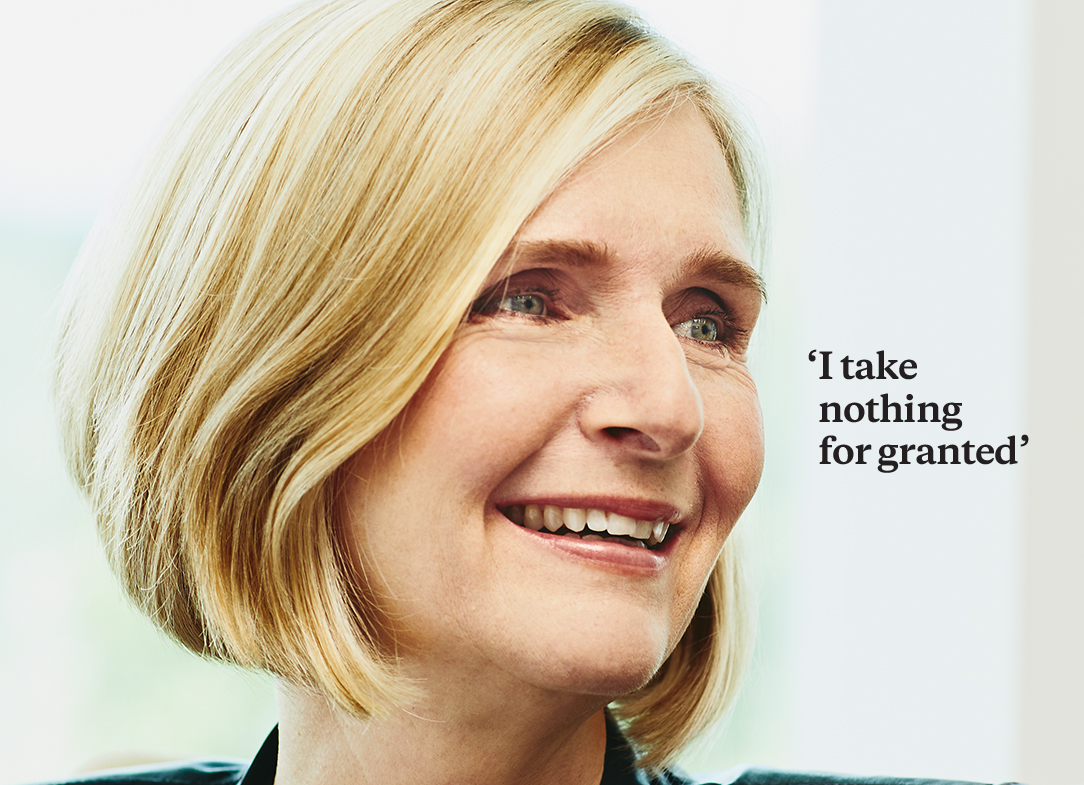Linda Galipeau was no stranger to the staffing industry, having seen her mother temping as a secretary. Galipeau herself took temp summer jobs as a university student and eventually rose to be head of Randstad, North America, managing a $6 billion portfolio. Galipeau is the only woman on the executive board of Randstad Holding nv; the €20.69 billion company offers a wide range of services in the HR space and is the second-largest staffing company in the world according, to Staffing Industry Analysts’ research. SIA President Barry Asin and Editor & Publisher, Media Products, Subadhra Sriram, talked with Galipeau about her journey, including starting Randstad Canada, the acquisition of Monster and the impact of artificial intelligence, as well as the role of women and where this industry is heading.
SIA: What got you interested in the staffing industry?
LG: My mother was a temporary secretary when I was growing up. She had left work to raise her children and when she wanted additional money for family vacations, or a project, or something, she would go and temp. So that whole agency world was one I was very familiar with, and when I was a university student, I temped also.
Then I got my MBA during a pretty tough labor market. I worked for a year for Pitney Bowes selling photocopiers. After a year, I was doing well but wasn’t very passionate about it, so I went back to an agency that had helped me find a summer job and asked, ‘What else could I do? What other jobs might you have for me?’ And that’s when they said, ‘Have you ever thought about doing this?’
What about the industry clicked with you?
I’ve always been passionate about the product [in staffing] — the intangibility of it. If you’re selling a tangible product you are kind of defined by it, restrained by it. Whereas in our industry, companies have been very good at creating and recreating themselves — putting together solutions to answer specific customers’ needs; then building products around that. I’ve always loved that about our industry.
Tell us about your career path.
I started in the industry as a permanent placement consultant in 1988, and then I became a branch manager, and then an area manager. In the early ’90s, I had moved with my husband to Boston. He was a medical resident at the time and he wanted US training. Three years later his training took us to Memphis. At the time I was working for another staffing company who already had an area manager for Memphis, and I didn’t want to go backward. During an interview, I heard about a Dutch company called Randstad that had bought a Tennessee company called James Jones Enterprises and was planning to open numerous branches throughout Memphis. I had actually driven by a Randstad branch earlier, but wasn’t aware of what it was.
At the time, many staffing firms in the US had a reception desk and an elevator between them and the candidate. To have an office right on the street was unusual. It was more common in Europe. So I went back and they were actually having a career open house for internal staff, and I ended up being hired as the district manager for Memphis and Southaven, Miss. That was in 1995.
In ’97, my husband had finished his training and we wanted to go back to Canada — and Randstad was not in Canada. I had the privilege of knowing [company founder and then-CEO] Frits Goldschmeding. I wrote him a business plan to start up Randstad in Canada, and he let me do it.
I began in Canada with the first branch in Montreal in ’97; by 2008 we had grown [organically] to $150 million before making our first acquisition in Canada — of Vedior in ’08.
That’s significant growth. What was key to achieving it?
In initially launching in Canada, I had enough time to decide where I was going to start. But I think that the growth strategy from the beginning was based on a couple of things. No. 1, we started in a market where we could win a position from which we could grow. So, very often when people enter markets — for instance, if they’re going to enter a metro market — they’ll put their first branch right downtown, which is, of course, the most saturated, difficult both for talent and for clients. And I didn’t do that, I went on the outskirts. I took a lot of time to pick where that first branch office would be so it would be a competitive advantage, not a disadvantage.
What staffing segments were you involved in?
We started in office, but at the time Randstad was not in favor of perm; they believed that with temp and perm, there would be a natural cannibalization. So, for the first year, we didn’t do perm. Then we changed our strategy because the Canadian market is such a big perm market and the demand from clients and candidates was clear. That was the first of many times where I learned the Dutch way of thinking — the Dutch are entrepreneurs and do not expect letter-by-letter compliance when it comes to business strategy; they expect local leaders to make intelligent choices, provided they are consistent with the strategy and values of the company.
The Dutch will listen to good business arguments. You have to be open, you have to tell them what you’re doing, but they’ll listen. So about 14 months in, we decided to expand our services to perm, temp-to-perm commercial staffing, primarily white collar. We eventually got into blue collar, but believed if you do blue collar at the beginning, it sort of consumes you. And we absolutely focused on the retail market, not the large account market. If you start accepting large customers early on, I don’t think you ever develop a meaningful retail business.
So to reach $150 million, you must have opened branches across the country. That’s a lot of hiring and development of talent.
Yes, it was. And we virtually never hired people from the competition at that time. Our model in Canada was different enough that we felt we could grow our own and build our own, and that was very successful. We spent a lot of time focusing on success profiles. I used industrial psychologists extensively and did lots of interviews.
We would look very, very closely at the profiles of people, the top 10% [versus] the bottom 10%, so we learned about the right profile for happy and successful employees. The people we hired stayed and they excelled. We spent a lot of time focusing on the profile that did well and then focusing on building our company around making people successful, happy, and stable. I’d say that was a critical strength of ours; we had always had very low turnover compared with the rest of the industry.
I think that’s continued to this day, and that made a huge difference. Also, if you look at the leadership team in Canada today, many of them were there from the beginning. Spending that much time on every single new hire, we really were able to build people who grew with us and we become parts of each others’ stories over the many years. A huge source of candidate success is this very strong stable team — people who were so carefully selected.
What’s your leadership style?
I think, like everybody, I’ve got my bright spots and my dark spots. I take nothing for granted. I have always believed in scrutinizing success as much as we scrutinize failure. Even when we’re doing very well, we still dig in and analyze and say, ‘OK that piece — be it that branch, that account, that model — is doing well. Let’s invest, and this area over here is struggling; let’s fix it.’
So even if the picture is rosy and we’re growing, we still very much do that diagnosis at a business-unit level, at a branch level, even on an employee level. This is very much a Randstad thing, but it’s all in how you do it; we’ve always partitioned investment. So we’ve made sure that the successful areas aren’t paying for the weak areas. And I think if you tend to look at your business from too high a level, there’s that cross-subsidization of success and weakness that happens accidentally.
And we’ve taken much more of a detailed approach. Leaders who are doing very well don’t necessarily expect others to be digging around in what’s wrong with them and don’t expect to show up at [quarterly business reviews] and say here’s all the things that’s going well and here’s my investment plan. At the same time, here’s all the things that’s wrong with my business, here’s the stuff I wish I didn’t have to tell you about. And here’s the plan to fix it. Not everybody likes that, but that’s a very Randstad thing, and very much my own style as well. I’m always surprised when I hear, even on earnings calls, leaders say, ‘We’re down but we’re down because of this big customer. But if you exclude all the areas we’re down, we’re actually up. If you get rid of all the places we’re shrinking, we’re growing.’
But you never hear the reverse. You never hear, ‘We’re growing, but actually not doing that well. We won this big account but the rest of the company is atrophying.’ You never hear that. I’d say that’s a key part of my style. And the leadership culture of Randstad is you’ve got to be willing to open the doors and tackle the weak points, and discuss them openly. So anybody who struggles with that typically struggles with me.
How did you go from leading Randstad Canada to all of North America?
In 2008, we bought Vedior and Randstad in the US went from being a generalist, $1 billion staffing player to a $2 billion company. On the staffing side, Randstad in the US had struggled, our profitability was quite weak. We really had not outgrown the market. The Vedior leadership brought professionals expertise that we didn’t have, but the staffing side remained a bit of a gap. So I was asked to come and take over the staffing side. I took over the commercial staffing operations and did that from 2008 ’til the SFN Group acquisition in 2011.
Then in 2012, Greg Netland [who headed North America] left the company; that’s when I joined the (Randstad executive) board and became responsible for all the US, Canada, at the time Mexico, now the UK, and then other things have been added over time: RiseSmart, SourceRight (globally) and most recently, Monster.
What is your perspective on the transition in the industry toward the gig economy? Is the Randstad Innovation Fund a part of that?
For about five years we were focused on what are the potential threats and clear opportunities in our industry. As people started talking about online staffing, we became very interested and very aware of the perils of blindness and being the classic disruptee. I think we clearly understood that we fit that description but weren’t quite sure what to do about it.
We were doing the usual things. We recognized that we were in new terrain and we really had to change how we think about this. Before we decided what to do, I think we really worked on what our lens would be, what the machine would be by which we would disrupt and transform ourselves and how we would really open these windows. The key to our success — at Randstad, like many companies — for so long was not to get distracted and to stick to the basics. It was what we did so well.
You remember Monster was launching, LinkedIn was launching all these things, and we really stuck to our knitting — and you know we knit well. But I think we realized that we were probably entering a very different time. So, we’ve taken a multi-pronged approach about the Innovation Fund, and it’s probably the first thing we did.
When we started the fund, I’m not sure we entirely knew where that was going to lead, but we identified an amount of money we would invest. We had two people in the company [we put on it]. One was Ilonka Jankovich — whom we had bought a couple of companies from. We kept buying companies and pieces of her companies and then she’d transition, move on to more entrepreneurial things. … She was very knowledgeable in this space, an extremely good networker, and a very entrepreneurial and disruptive thinker. Then we had Paul Jacquin, who worked in our finance organization and had the optimal combination of a brilliant investor mindset and a deep understanding of digital.
Our mandate to them was to know what we don’t know, to gain insight into technology development, to serve as our thought leaders and [develop] our whole innovation strategy. We wanted to understand what our extinction might look like and what we could do to prevent it. That was the philosophy at the beginning. It has gone so far beyond that. We have definitely evolved in our thinking and how we leverage the fund.
At the beginning, we were talking to companies that wanted our money from a very early stage. Today, the companies we are investing in do not need us. Often, we have to pitch to them as to why they should accept us an investor. There are companies that we think we could add value to each other. Very often the companies we’re talking to, their biggest challenges are certainly scaling and having access to enterprise customers. It’s extremely difficult. It’s extremely difficult for [the innovators] to have a strong commercial engine and of course one of the worst things that can happen to them is to become very client-dependent.
So, they land a big fish and then build everything around that. That’s a very good way to lose your way. Many of them are aware of that, but it’s very difficult not to fall into that trap. For us, I think that the learning is not only about the tools themselves, but about the culture. The understanding of, ‘What form is artificial intelligence taking, what are the current best use cases in AI, where are they going, who is doing what, who is who.’ You know, how they’re thinking about it, how we should think about it. All those things far exceed your expectations and we’re only getting started.
To what extent do you think the gig platforms, online staffing will be truly disruptive to the industry? How is it likely to shake out?
I think the answer is multifaceted. First, I’ll focus on North America, because in Europe, I think the speed and the nature of change will be somewhat different, as we’ve seen with many other things. If you think about the US, I’d say proximity to disruption matters — and disruption might be the wrong word. If you think about the [small to midsize enterprise] perm space, for example, I think there will be a model shift. And I don’t think we’re that far off from that happening in that space. It’s got all the pieces; the technology is pretty close. The good news for our industry, is that could actually expand the percent of hires that are made with the assistance of a third party like a direct hire firm or services platform — so you can view it as a risk or an opportunity.
The buyer in this segment is buying access to talent to fill a specific role in an efficient way and they’re making a small volume of hires per year. They certainly want to work with somebody that’s going to help them access that talent and then broker the match — this segment has probably already seen some disruption. I think that the potential for the model to shift and become far more tech and touch is there and maybe have some very different players rising in that space. I don’t think that’s that far off.
Are you’re talking about this in selling to small and midsize businesses and the like, or do you mean more like SME staffing firms?
I’m talking about end clients, but in some cases it’s the same. In many geographies, the [staffing firms] that have those small and midsize clients are themselves small and midsize. But I think there’s enough friction there, which is always the beginning. I don’t think anything is end-to-end tech. We call it tech and touch. It very much is an offering where technology and human interaction are just positioned a little differently than they are today. A lot of the platforms today take the candidates into the funnel up to a certain point in, but don’t yet in most places go all the way to the place that hired.com does, for example, but they operate in a very specific niche.
Have we seen branches peak, as it were, in the industry?
In blue-collar [segments], while we may see fewer branches, we’re going to continue to see branches for some time to come. A lot of the hiring process in blue- collar is still quite high-touch. But most definitely, as we go up the skills chain, there are going to be fewer branches or just different branches. I think branches used to be very candidate-facing. Now, branches are becoming increasingly client- or market-facing.
I think the talent would far prefer an experience that did not involve them driving to an office, finding a parking space, waiting at reception, etc. I think the talent will celebrate having an experience that’s more built around how they want to look for a job. I think increasingly branch offices are going to be built around clients, so proximity to our customers, having a sales force that’s in the market. [As a result], the role of the branches will change.
There will still be large centers focused on talent engagement activities, but I think they will be fewer and larger. If you look at our footprint 10 years from now, it will look quite different. However, that’s happening the slowest in the blue collar [segment]. There’s many aspects of blue-collar that lend itself more to many small offices, but that also will change over time.
What do you envision for enterprise clients and large staffing firms?
You are going to increasingly see the big enterprise customers and [staffing firms] like Randstad and the other big players make investments, building human cloud tools, building those into their offerings. Because what you offer customers of that size is a whole lot more than a match. It’s a far more strategic, solution-based product. It’s also a product with all sorts of regulatory and employer relationship-centric things where the sourcing of the candidate itself is only a very small piece. Here, we will see disruption of a different sort.
We will see the evolution of the MSP model into far more holistic talent models. The disruption in this segment is more around service models, more around technology truly integrated into those service models. It wasn’t always that much of a differentiator in the past; everybody could more or less access the same technology and the barriers to entry were much less.
I think the role that technology is playing now, how we build integrated solutions and the client’s savviness in picking the right players in terms of being their HR service and technology partners, we’ve seen a huge evolution in that.
So, I think that there will be more of a shift in competitive landscape than a disruption scenario, meaning large industry players will dominate, but the factors of competition will evolve.
Would our industry leaders have to be much more tech-savvy given the future of the business, or do you see a divergence there where some become high-tech and others become very high-touch?
It definitely takes both. I wouldn’t describe myself as high-tech even today. I think it takes both pieces. And understanding how to leverage the technology that’s coming, understanding what the digitization of our business is going to look like — that has something to do with tech-savvy, that has something to do with intellectual curiosity. The leaders that are really going to struggle are the ones that stick to their knitting when no one’s wearing wool anymore.
I’ve seen a lot of people who know surprisingly little about what’s going on, about what’s possible. You really have to understand what’s possible, where is it right now, where AI is now and where it is going to go. If you’re a naysayer, if you’re saying, ‘I’ve heard this before, that’s what they said when the job boards came, that’s what they said when social media came,’ I think that’s the bigger risk.
I haven’t spoken with a lot of technology players, but where they seem to hit a wall is how a customer interacts with an HR services provider; that’s really a blank space for them. They understand how the technology works, they understand the B to C engagements of talent, how to create a much better experience with digital platforms. But the service aside, if we could put those two pieces together then we’re going to see some very interesting things happen. It’s going to result in co-creations. I think we’re going to see a lot more partnership in the future than we’ve seen in the past. So, the leaders have to be tech-savvy. They also have to be open-minded, flexible, intellectually curious, and they have to be better at surrounding themselves with people who know a lot of things that they don’t know and listening to those people. It is also very, very humbling. I can’t tell you how many times a week I say would you explain that to me, please? Would you run blockchain by me one more time, please?
How does Monster fit into your strategy?
Monster was certainly a move that we had contemplated at different times. I think we got the timing right — time will tell. No. 1, we knew that we could digitize our business, and we are doing that. We are introducing many digital tools and platforms into our existing business models; we’re doing that and other companies are doing that. But to take a different angle on your business, one that is potentially cannibalistic, we think you have to do that, too.
And we saw different companies, digital-first competitors coming at our space from a different angle. And in many cases, offering things to customers and actually to other staffing firms that could be cannibalistic to us but could also expand our market and create new opportunities for us. Look at some of the offerings — some of the online players. These lines are converging. To do that just from our Randstad platform, we thought it was unlikely to do it quickly, at scale, and in a meaningful way.
No. 2, we were, and are still, very reliant on third-party recruiting resources and platforms., most of which are not designed with our industry in mind. Many times, they are designed with the sheer intent of disrupting our industry. And very often their functionalities and tools are not designed to promote our industry.
Look at Google. Google has great potential to be an amazing resource, but there are many aspects of Google development that may be more challenging for the staffing industry.
Think about work location, one of the ways people like to [job-search]. Where’s the job going to be? Staffing [firms will] have to think very carefully how do to respond to things like that. How do you provide the information that a candidate wants to have when they’re deciding whether to apply? In the context of our model, what is the most constructive, smartest way to do that?
Tools like Google, LinkedIn and Zip Recruiter challenge our industry in ways that we are very well-placed to respond to, but it’s much easier to respond if we have both the inside-out and outside-in perspectives. Purchasing Monster helps us make sure that there’s creation and innovation that is beneficial to our industry.
There is the risk of our industry being marginalized because a lot of the creative effort and focus in HR Tech could result in the unintentional disruption of our parts of our industry, while expanding other parts. We made a big decision when we got Monster, understanding that it would be for the benefit of us — and everybody else in our industry. Monster is definitely helping us speed up our own digitization, so the expertise that Monster brings — their expertise in SEO, their understanding of online platforms and digital business models— it is going to save us many, many years.
Especially as we roll out products like RiseSmart, for example, that are digital-first platforms. You need a B2B play, you need to be able to go to market perhaps in a new digital way. Right now, like all digital platforms, they’re sold the old-fashioned way and then delivered digitally. So as you see models like that evolve to a more digitized [model] and go to market — Monster will certainly help us do that.
Coming back to our industry, any leader in our industry today who is well-versed in digital is obsessed with two things. First is talent experience. How do we offer a better competitive talent experience, and recruiter productivity? And then, how do I leverage this in a way to maximize my recruiters’ and customers’ chances of success? The work we’re doing with Monster is very much focused on those two things.
Artificial intelligence may be the technology of what’s next. How will it first affect the industry?
I think that the impact of artificial intelligence on our industry and on all industries, of course, will be the big driver of what digital will become, because when you think about it, artificial intelligence allows individualized, highly predictive, highly personal experiences to be delivered in an efficient way. If you think about the talent experience that AI will provide, you know the efficiency aspect of AI, the matching capabilities of AI, all the advances that are going to happen on the back of AI.
And AI is still very much in the early phase. But the potential of AI — if you think of data plus processing power plus accessibility through the web, plus an evolving regulatory framework — where those things will take us, as all of that continues to advance will be transformative. Now again, it can very much be a helium balloon for our industry because all of these technological advances in the past have benefited our industry the most. We are typically the ones that adopt these things and build models around them. I don’t think AI will be any different.
Adding value without time constraints is the promise of AI: better sourcing capabilities, proactive communication, a unique experience to every candidate. We’ve only begun to understand what AI can do. It will be the most compelling transformative force in the coming years.
As this technology continues to impact the industry, how will the recruiter’s role likely change?
The role of the recruiter [varies by] skill category today, anyway. In some cases, they’re holding rulers, and in other cases, they’re holding magnets. In all categories, the art of recruiting is making a great connection between talent and opportunity.
When you think about some of the limitations of AI, the biggest one — and I’m certain we’ll get beyond this — is it runs the risk of perpetuating unconscious bias. And if you think about why so many people come to our industry and the conversations we’re having, they’re looking for the next thing, not another version of the old thing and companies are looking for more diversity, not necessarily more people with the same profile as the ones they have.
Now AI will get to the point that it will understand that, right? It will predict your next move and when you’re likely to make it. It will help you unearth opportunities you may not have considered. There’s no question about that. A candidate wants the technology piece to offer them access — to offer them immediacy, to offer them transparency, and then they want the touch piece.
Candidates are not saying to me, ‘I want a more automated process.’ They’re saying, ‘I want an efficient process. I want to automate the things I can automate, but then I want to talk to a person. I want to understand things, I want to ask my questions. I want them out representing me.’ There’s absolutely a demand among talent. This is what will drive, ultimately, the end state we pursue.
There’s a demand among talent for a greater amount of humanity, but efficiency is driven by technology. Right now, humanity is inserted in places that can be better done by technology. I would rather apply for a position, maybe go through some level-one screenings and know that I’ve been considered. … So get the level-one screening, and then right away have an opportunity to talk to somebody, as opposed to sending their resume off and hoping somebody is going to take a look at it. So talent are saying, ‘I want more technology here and I want far more humanity there, please.’ If we can work on this now and get that balance right, I think that’s going to be the winning formula.
There is are a large number of women in staffing, but not that many at the C-suite in our industry. What advice would you give to women?
We’re a female dominated industry, but you wouldn’t know that during results season. There are a lot of deep voices on those [earnings calls]. A lot has been said about that. The No. 1 thing I would tell women is to rethink their relationship with failure. I think women need to have a far more constructive relationship with failure, a more constructive view of it.
A lot of decisions and moves you need to make today and what companies are looking for their leaders to make — especially if they’re going to bring something new — require taking risks. Taking measured risks, failing quickly, adjusting, tweaking, trying again but also recognizing failure for what it is and learning from it. Women are not always as comfortable with taking risks as men are. Many are, and they’re very often successful, but others are not. And failure is taken very personally. Men are better in general [at that].
But I find men are better at internalizing success and externalizing failure. And women often do the reverse. So when they’re successful they thank their teams and their families and their good fortune, and when they fail they blame themselves. In many ways that’s a success thing. But I think if women can get more comfortable with failure, and as a result of that more comfortable with risk, I think we’re going to see a lot more women at the top.
What are your plans for the company?
It sort of feels like a beginning — more than it did even five years ago. The whole tech and touch journey, although we’re three or four years into it, we are also just at the beginning of the work we’re going to do and the things we’re going to build. And I’m extremely excited to be a part of that.
The MSP business is sort of the same thing. I think that Randstad was initially slow to the table last time, but recovered when we acquired Sourceright. When we talk about the evolution of that model, I think we’re very excited again. We’re at the beginning of a whole new wave of the kinds of talent solutions and programs our client is going to be buying. And we’re very excited about our entrance into outplacement business. That has been a gap for us. And it’s very interesting to be able to start in a business with a digital-first player. So, on one hand, we’re working on digitalizing our traditional business models but you know with RiseSmart, we’re scaling a digital-first player, which is very exciting. And lots of learnings there for sure.
What advice would you give to owners of smaller staffing firms about where the business is going and what it takes to be successful?
First of all, they have to have a good, well-informed view of the future. I think that’s extremely important. And I think well-informed there is the key. So to make sure that they are taking in everything they see around them.
Technology, disruption and the evolution of the industry and the MSP/Total Talent Management model — I think that will affect them,. I think with the rise of the MSP models, many of those companies have found a fantastic niche in small and midsize customers, delivering more personalized service. But again, that’s the next wave of disruption. They have got to make sure that their value proposition resonates in a more technology-enabled world, because those customers are also looking for how to leverage the power of HR technology to drive their employer brand and compete for talent.
I would also look very closely at the skill categories that they service. Certain skill categories are growing and will continue to grow. And other skill categories are either plateauing or diminishing.
Don’t get to wedded to one particular place, especially if it’s a place that is ripe to be robotized. Also understanding the outlook because as jobs are destroyed, other jobs are created. But you’ve got to make sure you’re continuing to evolve that. Your business can be wedded to some pretty high-risk job categories. So it’s all about making sure you’ve got the right amount of inside and outside input to continue to evolve your value proposition. I think that will be key to survival going forward.
The small company angle is a very important one. Smaller companies have often been very good at offering a very high caliber of talent experience and building long-term relationships with customers. They need to remain focused on those things and learn how to deliver them in a perhaps more digitally enabled way. That will be critical and it’s a huge opportunity for that segment of our industry to continue to show its value. I do think talent experience will become one of the most important elements of competition — even more than it is today; I think we all talk about it, but, from the talent’s perspective, there’s a lot of opportunity for improvement.
And if you look at some of the disruption in the other industries, it has been friction points similar to what we see in our industry that have prompted people to consider new business models, new ways of doing business. I think it’s also important for the small and midsize firms to continue to build on their areas of strength. They have a leg up. They just have to make sure they maintain their advantage by making the right investments and the right strategic choices.







